
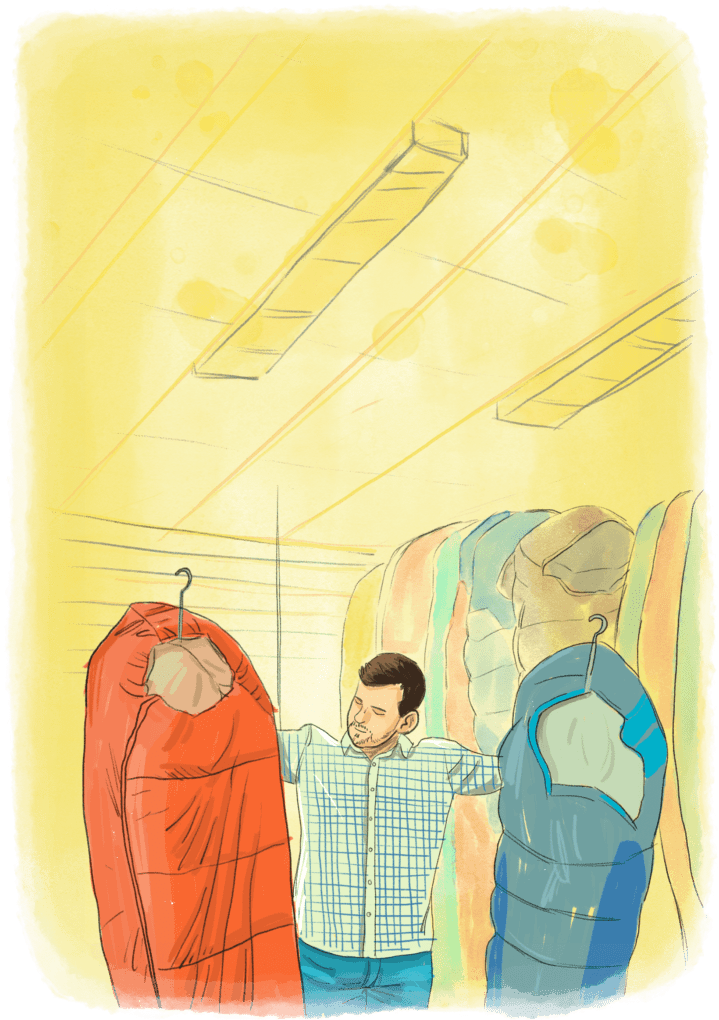
L
ots of round-the-world (RTW) travellers are in two minds about taking a sleeping bag. It’s heavy, but it’s reassuring to know that you’ll be able to keep warm when you sleep in all conditions. In this article, we’ll talk about the advantages and disadvantages of a sleeping bag when travelling, so that you can make an informed decision. We’ll go through all the criteria to take into account when selecting a sleeping bag that’s right for you. To help you make sense of it all, we’ve also carefully compared the models most commonly used by travellers.
We carried out a large survey from 1st to 5th December 2017, amongst 404 long-term travellers, in which we asked them if they’d taken a sleeping bag, if they’d rented or bought one on the road and what the features were of their model. Learn more about our methodology
Around two-thirds of RTW travellers take a sleeping bag.
Only 4% of those who didn’t take a sleeping bag regret not having taken one. Those who took one are four times more likely to regret their choice (16%).
The decision of whether to take a sleeping bag or not depends on several factors:
If you’re biking, hitchhiking or going on foot, you’ll most likely need a lightweight sleeping bag that’s suitable for the temperature of the countries you’ll be visiting.
However, the question arises for those who travel with their vehicle or on public transport; that is, the vast majority of RTW travellers.
Taking a sleeping bag increases the total weight of your kit by 5 to 10%. It also takes up a lot of space.
As you know, we’re in favour of travelling light because it offers many advantages: comfort, autonomy, speed, discretion, ease… (see our article on travelling ultra-light). Therefore, we recommend carefully examining your needs to determine if you really need to bring a sleeping bag and to avoid taking one “just in case”.
If you mainly travel in hot countries, you won’t have many opportunities to use your sleeping bag. It’ll be more cumbersome than useful. If you plan on spending just a short amount of time in cold areas, you may consider renting or buying one locally (see the renting or buying section).
If you start your trip with a long period in cold areas, it may be a good idea to take one.
You’ll ultimately be able to sell it or hand it on to someone else when you set off for places where the weather’s milder.
Even if you don’t sleep in a tent that often, in some parts of the world, hotels and hostels aren’t always heated. So, a sleeping bag can save you from having sleepless nights, shivering in the cold.
However, in most accommodation, even if there isn’t any heating, they provide big blankets that are usually enough to keep you warm. In the rare cases where that isn’t enough, sleeping clothed in your sleeping bag liner normally does the trick.
According to our survey, the countries where travellers need a sleeping bag the most are Mongolia, Nepal, Russia, New Zealand, Chile, Argentina, Bolivia and Ecuador.
In most “poor” countries, buses have an annoying tendency to turn the air conditioning on full blast. Nobody knows why, it remains a mystery, but on some night buses, it’s so cold that you can’t get a wink of sleep.
Air conditioning on buses may be reason enough to take a sleeping bag. However, you can also protect yourself from the cold by wearing warm clothes on buses and sitting in your sleeping bag liner, or wrapping yourself in a blanket.


It often feels like the North Pole on buses
Many travellers take a sleeping bag to use when trekking. Indeed, if you’re going to do several-day hikes at altitude and sleep in tents or unheated gites, you’ll need one.
However, in the most popular hiking areas (such as Cuzco, Salar de Uyuni, Sud Lipez, Patagonia, New Zealand, Nepal, and so on…), it’s easy to rent or buy a good quality sleeping bag (see the renting or buying section). Therefore, in our view, there’s no need to weigh yourself down with a sleeping bag if your main intended use is trekking, unless you do a lot of it.
Among the RTW travellers who took a sleeping bag, 69% camped at least once and 28% camped more than one out of five nights. Even in hot countries, it can get too cold at night to sleep without a sleeping bag. If you intend on spending many nights in a tent (not just during your treks), you’ll most probably need one.
Likewise, if you’re travelling with your own vehicle in cold areas, you’ll need a sleeping bag or a duvet / blanket.
You don’t need to have a sleeping bag to do couchsurfing or wwoofing. However, if you plan on doing it a lot during your trip, it can come in handy, as your host won’t necessarily have a duvet or blanket for you.
To limit your budget, you’ll no doubt stay in hostels, guesthouses or budget hotels. Depending on the place you go to, cleanliness won’t always be a priority. For the sake of hygiene, some travellers prefer to use their own bed-linen. However, for this type of use, a simple sleeping bag liner will do the trick. What’s more, some hostels ban the use of sleeping bags in their beds, as they’re one of the main spreaders of bed bugs.
Lots of RTW travellers alternate between hot and cold areas during their trip, which makes it harder to decide whether to take a sleeping bag or not.
To get around this issue, some travellers go without a sleeping bag and rent one from time to time or buy one when they get to a cold area.
Others choose to take a lightweight sleeping bag that isn’t that warm and rent a warmer one when they need it, for example, for a trek.
For some treks, like the Inca Trail in Peru, you have to go with a guide. For others, it’s strongly advised. In this case, a sleeping bag will often be included in the agency’s service. If this isn’t the case, you can rent a cheap one from the agency.
Generally speaking, the kit provided by the agencies is of decent quality, as they’d risk their reputation if they gave you poor quality equipment.
If you’d rather not go through an agency or a guide, then you’ll have to contact a specialised shop to rent or buy your sleeping bag. In cities where lots of hikers go, such as Cusco, Huaraz, Puerto Natales or Kathmandu, you’ll find them very easily. Elsewhere, it’s often a little more difficult.
Sleeping bag rental usually costs less than $3 (£2) a day, except in rich countries, where it’s often cheaper to buy one.
Finally, the last option is to find a traveller who’s about to go to a hot country and who can sell or give you their sleeping bag.
Some travellers are reluctant to rent or buy a used sleeping bag, as they’re afraid that it’s dirty or, worse, that it’s infested with bed bugs. If this worries you, a more psychological than effective solution is to sleep in your sleeping bag liner, inside the sleeping bag, which’ll add a “protective” layer of cleanliness.
Buying from a local brand is a good way to get a good quality sleeping bag at a reasonable price.
If you plan on buying one when you arrive in South America, the Chilean brand Doite offers excellent value for money. There are many Doite shops in the country.
The Nepalese brand Everest Hard Wear also has a good reputation.
In “poor” countries, lots of shops sell or rent counterfeit gear. In Nepal, they’re called “North Fake”. If the prices seem particularly low, beware.
It’s better to rent or buy equipment that’s a little worn from a well-known brand, or a local brand, than a brand new counterfeit one. Believe us, you really don’t want to have the harsh realisation at 16,000 feet (5,000 metres) that your sleeping bag isn’t keeping you warm enough.
If you have a guide, ask them for advice. If not, talk to other travellers, check a guidebook and reviews online before choosing your shop.
In some cities that are very popular with trekkers, such as Kathmandu, the major international mountain gear brands (The North Face, Vaude, Colombia, etc.) have opened shops out there. You can be sure to find good quality equipment, but the prices are the same as those in Europe.


Have faith in the quality of The North Faith
Here’s a list of shops, recommended by travellers, that sell or rent good quality equipment in the main trekking areas visited by RTW travellers.
Chile:
Mongolia:
Peru:
Nepal:
If you leave a cold area and plan on staying in hot areas, we advise you to get rid of your sleeping bag so you can save some space and lighten your load. There are several possible solutions:
Who rented a sleeping bag?
Who bought a sleeping bag?
EN13537 is a European standard used by sleeping bag manufacturers to indicate temperature ratings. This standard requires a test in an approved laboratory. Non-European brands don’t display this standard on their models, but often use the same tests to determine the temperatures stated.
There are three temperature ratings:


An example of a temperature label
When choosing your sleeping bag, the comfort rating is your point of reference. Consider the geographical areas, seasons and maximum altitudes of your trip to figure out the temperatures you’ll face at night.
Everyone has a different sensitivity to the cold. If you feel the cold, choose a bag with a comfort rating that’s a little lower than those you’ll face during your trip.
On average, RTW travellers take a sleeping bag with a comfort temperature of +10°C (50°F). It ranges from -10°C (14°F) for the higher-performance ones to +20°C (68°F) for the ones that aren’t as warm.
Travelling light is pure freedom. Depending on the model you go for and the weight of the rest of your gear, your sleeping bag will increase the overall weight that’ll weigh on your back for several months by 5 to 10%.
Down sleeping bags offer the best weight-to-temperature ratio. But there’s no secret, generally speaking, the warmer the bag, the heavier it is.
However, some slightly more expensive models, like the Sea To Summit Spark SP0, manage to combine ultra-light weight technology (225 g (10.5 oz)) and decent thermal performance (10 to 15°C (50 to 60°F)).
Unless you’re travelling with your vehicle, we advise you to choose a sleeping bag that doesn’t weigh more than 1.1 kg (2.4 lbs), even if it means paying more if you need a warm one.
Be careful, as lots of manufacturers tend to play down the weight of their sleeping bags by noting that of their smallest size.
The average weight of sleeping bags carried by RTW travellers is less than 900 grams (31.7 ounces). They range from less than 500 grams (17.6 ounces) for the lightest ones to more than 2 kilos (4.4 pounds) for the heaviest ones.
During a RTW trip, you’ll often have to travel on jam-packed buses. A sleeping bag that’s too bulky can be really annoying in the long run.
Manufacturers usually specify the volume and dimensions of the bag when compressed. Down bags compress much more. Therefore, they’re usually less bulky than synthetic bags.
The filling of a sleeping bag can be made of synthetic material or down. Each type of filling has its pros and cons. The main advantage of down is its incredible weight-to-warmth ratio. On the other hand, it’s more expensive and less resistant to moisture than synthetic material.
Advantages and disadvantages of down and synthetic filling
| Down | Synthetic | |
|---|---|---|
| Warmth : weight | Good warmth : weight ratio | Bad warmth : weight ratio |
| Volume : weight | Compresses easily | More difficult to compress |
| Moisture resistance | Absrobs moisture and loses its insulating capacity if wet. The protection of down can be improved by using a waterproof outer shell. | Keeps it’s insulating capacity, even if it’s wet. |
| Lifespan | Good durability, but may lose some down if pierced. | Average durability |
| Breathability | Good breathability | Bad breathability |
| Comfort | Comfortable | Not very nice to sleep in |
| Maintenance | Delicate wash at 30°, no spin drying. Tumble dry at low temperatures or air dry. | Easy to wash, dries quickly |
| Allergies | Risk of allergies in some people. | No risk |
| Price | Expensive | Inexpensive |
Down performance depends on four factors:
For people who are mindful of animal welfare, down can pose a problem, as the removal of feathers is sometimes done when the animals are alive. Therefore, some people prefer to choose a synthetic filling. There’s also a certification, Responsible Down Standard (RDS), which makes it possible to identify products whose down has been produced in a way that limits animal cruelty.
The performance of synthetic material is more difficult to compare, as there are so many different technologies. You’ll have to rely on the comfort temperature stated.
If you don’t need a really warm sleeping bag during your RTW trip, a synthetic sleeping bag will do the job. It’ll be cheaper, won’t be sensitive to humidity (which can be pretty high in tropical countries) and you can wash it.
If you need a really warm sleeping bag, you should probably opt for down, because the weight of a well-insulated synthetic sleeping bag is too heavy for a long trip. In this case, go for a model that’s protected by a waterproof outer shell.
64% of RTW travellers took a synthetic sleeping bag, 36% opted for down filling.
Sleeping bags come in two main shapes:
They’re more comfortable because inside there’s more room for your feet. They hold in lots of air and don’t have a hood. Therefore, they provide much less protection from the cold than mummy sleeping bags. They’re also heavier and bulkier. So, they’re more suited to people who travel by vehicle and camp in the summer than for backpackers on a RTW trip.
They’re much more fitted and are equipped with a hood, which reduces heat loss. For a given weight, they’re therefore warmer. This type of sleeping bag is popular with RTW travellers.
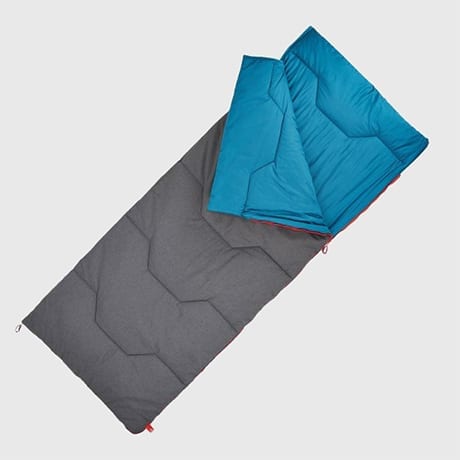

A Quechua rectangular-shaped sleeping bag
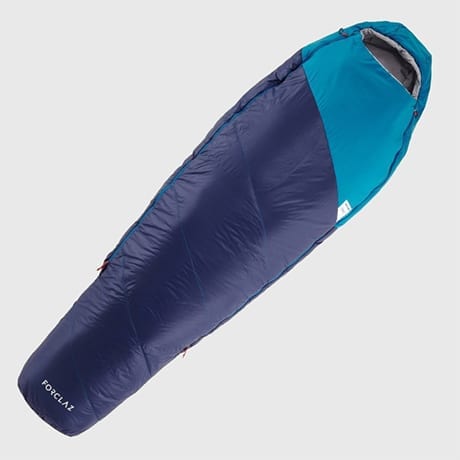

A Quechua mummy-shaped sleeping bag
There are also other types that are more original, but much less commonly used:
To find out more about these alternative types of sleeping bags, you can read this article on Advnture.com.


Or, there’s a sleeping bag suit – completely useless, but you’ll sure look trendy!
A good sleeping bag should have flaps above and below zips to keep cold air out.
If you’re travelling as a couple, you can choose double sleeping bags: one with a zip that closes on the right and another on the left.
Mummy-style sleeping bags have a drawstring hood. This means that you can tighten and adjust it perfectly, leaving only part of your face exposed, which prevents heat loss from the head.
On the warm models, there’s also a draft collar or a draft tube to insulate your torso.
Manufacturers usually offer several sizes for each sleeping bag model (S, M, L, etc.). Your sleeping bag should be large enough for you to turn around in, but not so large that there’s too much air inside and you lose thermal comfort. For the length, assume that you’re always taller when lying down. You don’t sleep with your feet at right angles.
According to our survey, the average price paid by travellers for their sleeping bag is $60 (£50). They range from $30 (£25) for the cheapest to over $400 (£340) for the most expensive. The cheapest are the Quechua ones sold at Decathlon. Some people, however, don’t think twice about investing in a specialised sleeping bag brand, even if it means paying whatever the price.
Here are the sleeping bag brands that our survey respondents used the most during their RTW trip:
| Brands | % |
|---|---|
| Quechua | 46% |
| Millet | 9% |
| Lafuma | 5% |
| Wilsa | 5% |
| The North Face | 5% |
| Mc Kinley | 3% |
| Lestra | 3% |
| Brands | % |
|---|---|
| Valandre | 3% |
| Deuter | 2% |
| Triple Zéro | 2% |
| Cumulus | 2% |
| Doite | 1% |
| Sea to Summit | 1% |
| Warmth | 1% |
In this section, we compare the sleeping bag models most used by RTW travellers according to our survey results.
| Model | Price comparison | Percentage of travellers who chose this model | Weight | Comfort limit T° | Comfort T° | Lining | Compact volume |
|---|---|---|---|---|---|---|---|
Forclaz Trek 500 15° Light
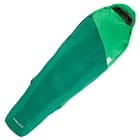  |
£35 ($41)
Decathlon |
15 % | 0.68 kg (1.5 lbs) | 10°C (50°F) | 15°C (59°F) | Synthetic | 27 x 14 cm (10.6 x 5.5 in) |
Forclaz Trek 500 10° Light
  |
£45 ($52)
Decathlon |
12 % | 0.97 kg (2.1 lbs) | 5°C (41°F) | 10°C (50°F) | Synthetic | 33 x 17,5 cm (13 x 6.9 in) |
Forclaz Trek 900 10° Down
  |
£100 ($117)
Decathlon |
12 % | 0.70 kg (1.5 lbs) | 5°C (41°F) | 10°C (50°F) | Duck down | 34 x 13 cm (13.4 x 5.1) |
Quechua Trek 900 0° Down
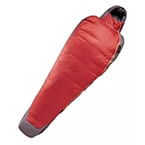  |
£150 ($175)
Decathlon |
6 % | 0.95 kg (2.1 lbs) | -5°C (23°F) | 0°C (32°C) | Duck down | 34 x 16 cm (13.4 x 6.3 in) |
Millet Baikal 750
  |
£100 ($117)
Snowleader Amazon |
5 % | 0.77 kg (1.7 lbs) | 6°C (42.8°F) | 10°C (50°F) | Synthetic | 20 x 15 cm (7.9 x 5.9 in) |
Forclaz Trek 500 5° Light
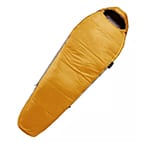  |
£55 ($64)
Decathlon |
4 % | 1.2 kg (2.6 lbs) | 0°C (32°F) | 5°C (41°) | Synthetic | 40 x 18 cm (15.7 x 7.1 in) |
Lafuma Active 10°
  |
£55 ($74)
Snowleader Amazon |
2 % | 0.7 kg (1.5 lbs) | 9°C (48.2°F) | 12°C (53.6°F) | Synthetic | 25 x 13 cm (9.8 x 5.1 in) |
The North Face Lynx
  |
£210 ($245)
Amazon |
2 % | 0.85 kg (1.9 lbs) | 1°C (33.8°F) | 6°C (42.8°F) | Synthetic | 35 x 22 cm (13.8 x 8.7 in) |
Wilsa Down Ultralite 150
  |
£140 ($165)
Ekosport |
2 % | 0.44 kg (1 lb) | 6°C (42.8°F) | 10°C (50°F) | Goose down | 26 x 11 cm (10.2 x 4.3 in) |
Cumulus LiteLine 300
  |
£195 ($228)
Cumulus |
1 % | 0.64 kg (1.4 lbs) | 0°C (32°F) | 4°C (39.2°F) | Goose down | 22 x 16 cm (8.7 x 6.3 in) |
Deuter Exosphere +2°
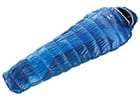  |
No longer sold See similar models | 1 % | 1.1 kg (2.4 lbs) | 2°C (35.6°F) | 8°C (46.4°F) | Synthetic | 39 x 16 cm (15.4 x 6.3 in) |
Doite Compact Down
  |
No longer sold See other models | 1 % | 0.9 kg (2 lbs) | 0°C (32°F) | 3°C (37.4°F) | Duck down | 32 x 18 cm (12.6 x 7.1 in) |
Forclaz Trek 500 0° Light
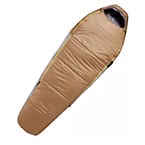  |
£70 ($82)
Decathlon |
1 % | 1.55 kg (3.4 lbs) | -5°C (23°F) | 0°C (32°F) | Synthetic | 42 x 21 cm (16.5 x 8.3) |
Valandre Bloody Mary
  |
£365 ($426)
Snowleader |
1 % | 1.18 kg (2.6 lbs) | -12°C (10.4°F) | -5°C (23°F) | Goose down | No info. |
Wilsa Down Ultralite 300
  |
£170 ($200)
Ekosport |
1 % | 0.67 kg (1.5 lbs) | 0°C (32°F) | 6°C (42.8°F) | Goose down | 27 x 13 cm (10.6 x 5.1 in) |
You sometimes hear people say that you should sleep naked in your sleeping bag to be warmer.
This is only true if you’re hiking without a spare change of clothes. In this case, if your clothes are made from cotton (take a long time to dry), it’s better to take them off to prevent your sweat from cooling you down at night.
In other cases, to be warm, it’s better to wear one layer of (dry) clothing in your sleeping bag. If you’re cold, warm up your extremities by wearing a hat, gloves and socks.
You can also use a sleeping bag liner to gain even more thermal comfort (see below).
As the name suggests, it allows you to compress the sleeping bag to gain space. It usually comes with it. It’s better to regularly take your down sleeping bag out of the compression bag, in the evening in your room, to prevent the down from losing its volume and fluffines.
Whether you take a sleeping bag or not, a sleeping bag liner comes in very handy when travelling. It can be used in hot countries, when hotel sheets aren’t clean. It also saves you from having to wash your sleeping bag all the time, and adds an extra layer of thermal comfort.
You should avoid cotton – it’s too heavy, not very warm and dries slowly. Synthetic is lighter, warmer and dries faster, but it’s not as comfortable and quickly smells bad. Silk is the best option in every way, but it’s more expensive.
We use this silk sleeping bag liner from Decathlon, it costs $40 (£35).
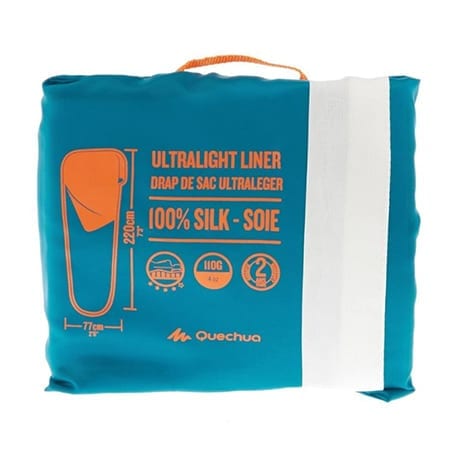

This silk sleeping bag liner only weighs 3.9 ounces (110 grams).
It’s a waterproof cover, or just water-repellent, for sleeping bags.
A bivvy bag is lighter than a tent and allows you to set up camp under the stars wherever you fancy, discreetly and you don’t have to fear bad weather.
There are several types of bivvy bags:
These are the lightest, but you need to cover the hood with something else, like a tarp.
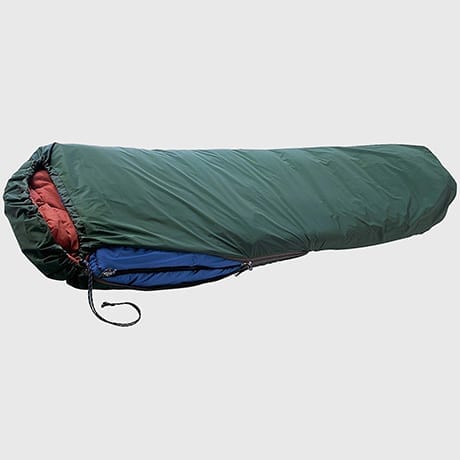

Open-hood bivvy bag
You can close the hood with a zip. They provide better protection from the rain, but they have poor breathability.
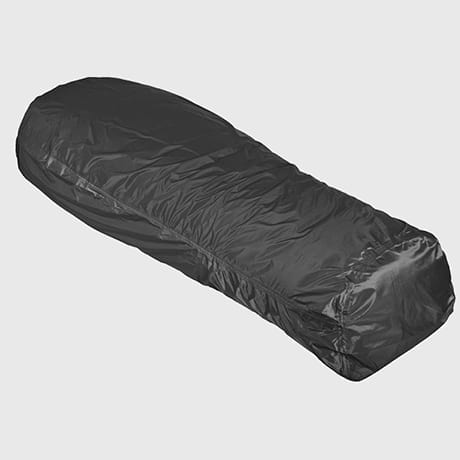

Closed bivvy bag
These are the most common, and a little less claustrophobic than closed bivvy bags.
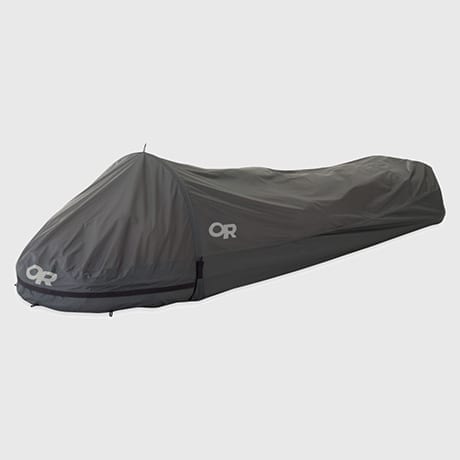

Closed bivvy bag with headroom
You can find more information on bivvy bags on the OutdoorGearLab website.
If you plan on sleeping outside, you’ll need a mat to sleep comfortably and insulate you from the ground.
They’re pretty cheap, sturdy, waterproof, light and quick to set up, but they’re quite uncomfortable and bulky.
They’re comfortable and compact, but they take a while to set up, and are heavy and expensive.
They’re compact, comfortable, insulating and quick to set up, but they cost more, and are heavy and fragile.
They’re comfortable, compact and inexpensive, but they take a while to set up and provide poor insulation.
If you intend to spend many nights outside, you have several options:
Some RTW travellers choose to make their sleeping bags themselves. This option means you can customise your sleeping bag however you like and it’s much cheaper than buying one from a shop. It takes a fair amount of time, but imagine how satisfying it’ll feel to have made your equipment with your own hands!
You can find more information in this guide on DIY sleeping bags.

